A chance to think through how the visual impact of text, image, and text with image.
24 Items in this Learning Collection
Copyright
Broom, Poems, and Poets
1969/2.24
Title
Broom, Poems, and Poets
Artist(s)
Yosa Buson
Artist Nationality
Japanese (culture or style)
Object Creation Date
18th century
Medium & Support
album leaf mounted as hanging scroll, ink and light color on paper
Dimensions
6 1/2 in x 11 1/2 in (16.5 cm x 29.2 cm);3 11/16 in x 17 3/16 in x 3 3/4 in (9.4 cm x 43.7 cm x 9.5 cm)
Credit Line
Museum purchase made possible by the Margaret Watson Parker Art Collection Fund
Subject matter
"Buson 's paintings can generally be divided into two styles. Nanga and haiga. Haiga are paintings meant to illustrate haiku poetry. The origins of this type of Japanese painting have yet to be carefully investigated. However, it seems that Basho, who played such a central role in the formation of the haiku form, also was one of the first to paint haiga. A number of Basho's simple paintings accompanied by his haiku still exist. These amateurish efforts established the norm that haiga should convey the quality of a casual sketch rather than a fully developed painting. Buson's haiga were influenced by the skills he had developed as a Nanga painter in the Chinese style. Just as Buson's poetry possessed a more urbane, worldly air than Basho's, so his paintings seem more sophisticated and elegant.
The Michigan painting which contains the signature, Yahan, must have been painted after 1770 when he received that title, and thus dates to the last period of his life when his best paintings were produced."
There are three poems written on this handscroll, "the second of these poems is published among Buson's miscellaneous verse while the last two are found in the winter section of the Buson Kushu.
The paper here has been carefully torn away just to the left of the last line of verse and another piece of paper, colored to resemble the original, inserted. This suggests that the original painting was wider, perhaps a handscroll that was later divided into sections for mounting as a hanging scroll. The delicate colors and playful brushwork exhibited in both the paintings and calligraphy combine to demonstrate Buson's great talent in making haiga, one of the most intimate forms of Japanese painting."
Adams, Celeste, and Paul Berry. Heart, Mountains, and Human Ways: Japanese Landscape and Figure Painting: a Loan Exhibition from the University of Michigan Museum of Art. Museum of Fine Arts, 1983.
Physical Description
"On the right side is a drawing of a straw broom accompanied by a single line of verse that reads,
Ippatsu ichiboku One stroke, one line
Soha zokujin Sweeps away worldly dust.
In a Zen fashion the poem suggests that one line of ink will clear away the confusion of everyday life. The sweeping action is materialized by the sketch of the broom.
The next poem plays upon the sweeping action mentioned above,
Yukuharu no Departing Spring's
Shiripeta harau Buttocks are brushed
Rakka kana. Of fallen flowers.
This personification of spring from whose departing hips the blossoms fall is transformed into a man in court dress who having enjoyed sitting under the flowering trees is being brushed of the petals that cling to his clothes.
The succeeding verse suggests the reason for his departure.
Hatsu shigure First shower of Autumn
Mayu ni eboshi no On my eyebrow
Shizuku kana My hat's raindrop.
The season has shifted to fall. The man stands to leave at the signal of a raindrop that has fallen from the crest of his tall hat onto his eyebrow.
The concluding poem moves the focus away from human concerns.
Sato sugite Passing the village
Furue ni yanagi o Along an old stream, a willow
Mitsuke tari. Is found."
Adams, Celeste, and Paul Berry. Heart, Mountains, and Human Ways: Japanese Landscape and Figure Painting: a Loan Exhibition from the University of Michigan Museum of Art. Museum of Fine Arts, 1983.
Primary Object Classification
Painting
Collection Area
Asian
Rights
If you are interested in using an image for a publication, please visit http://umma.umich.edu/request-image for more information and to fill out the online Image Rights and Reproductions Request Form. Keywords
Figures
Japan
album leaf
calligraphy
calligraphy (visual works)
hanging scroll
hanging scrolls
ink
male
poem
poems
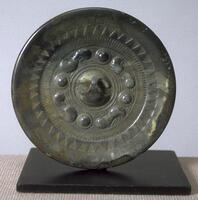
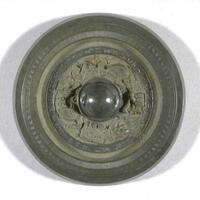






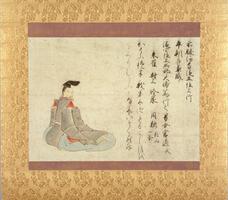
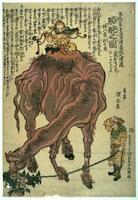

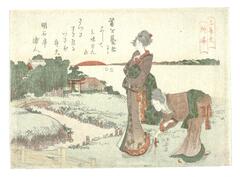
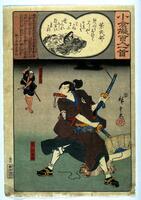



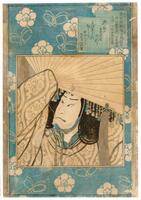
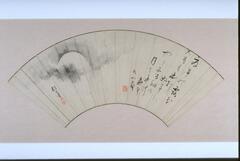

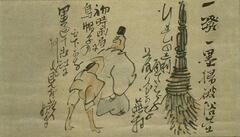

![In this monumental scroll, Nukina Kaioku has brushed a Chinese poem of his own composition, on the enduring theme of nature as refreshment for the spirit. Note his masterful variation of thick and thin strokes, wet and dry ink, stately and rapid movement.<br />The verses may be tentatively rendered into English as follows:<br /> Mandarin ducks enjoy the fresh water; their graceful forms glow as they pass through channels in the reeds.<br /> Pushing beyond the thickets [to the open pond], they call to one another again and again in the dawn.<br /> A crimson mist breaks through gaps in the glade, its glow warming hidden nests.<br /> Waking up with nothing to do, [I came here] to playfully row among the spring waves. In this monumental scroll, Nukina Kaioku has brushed a Chinese poem of his own composition, on the enduring theme of nature as refreshment for the spirit. Note his masterful variation of thick and thin strokes, wet and dry ink, stately and rapid movement.<br />The verses may be tentatively rendered into English as follows:<br /> Mandarin ducks enjoy the fresh water; their graceful forms glow as they pass through channels in the reeds.<br /> Pushing beyond the thickets [to the open pond], they call to one another again and again in the dawn.<br /> A crimson mist breaks through gaps in the glade, its glow warming hidden nests.<br /> Waking up with nothing to do, [I came here] to playfully row among the spring waves.](/media/W1siZiIsIjIwMjIvMDUvMjUvNDA4bXZmMmt5bF9kZWZhdWx0LmpwZyJdLFsicCIsInRodW1iIiwiMjQweDIwMCJdXQ?sha=1fda6bad9ec42b3f)


